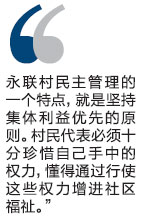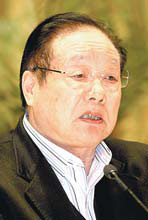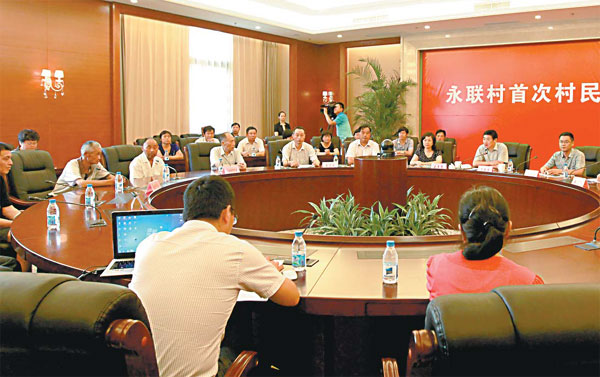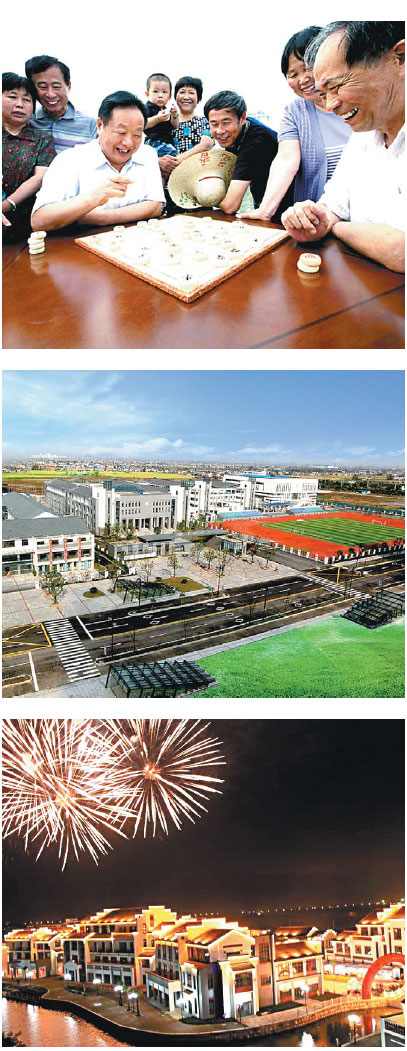Village democracy thrives in urban setting

Yonglian community builds modern industry, upholds open governance and strengthens education
Unlike in most meeting rooms, in the Yonglian Village Hall there is space between all the chairs that allows every person to leave his or her seat and get to a nearby microphone-equipped rostrum quickly.
"We make it easy to say 'no' in this room," said Wu Huifang, deputy-chief of the democratically elected village committee.
| Village representatives join the village council in a discussion about community affairs. |
| In the center of Yonglian's village square, in front of the meeting hall, there is a sculpture of five golden fingers - four fingers point downward, while the thumb reaches toward the sky - forming a hand that seems to be grabbing something. The five fingers represent the five old neighborhoods (which Chinese call "natural villages") that formed today's Yonglian. And the golden figure has certainly grasped the good fortune brought about by China's reform and opening-up. Yonglian is now one of China's most affluent and democratically governed villages. |
But Yonglian's village democracy is a lot more than just that. Before all the representatives of villagers come here for a formal debate session, the village leadership actually spends far more time on informing the villagers about the policies and projects it is planning, and in collecting their feedback.
"Otherwise, policies cannot be carried out properly even if they are passed in voting," said Wu, who is in his mid-50s and has been serving as the village's executive leader since the village's first-generation leader Wu Dongcai (not related) stopped overseeing its daily management.
But although they've cut short the decision-making process, a crucial part remains in place. That is for the decision-makers to learn from their "best teachers", the people who say no, and through learning from them, to know what adjustments they will have to make.
Through the 1990s, economic reform and the resultant increases in the community's and individual incomes allowed the villagers to think about an expansion in collective welfare and to seek more active participation in the management of local affairs. Village democracy, once seen as only an official propaganda ploy, began to develop in Yonglian, especially in income distribution, use of public funds and villagers' welfare entitlements.
One characteristic of Yonglian-style village democracy is that, while one person and one vote is the way to decide the most important affairs, a certain degree of representation is also needed.

Such a design allows the business-oriented villagers to concentrate on their lives whenever they can and allow those who are politically savvy to take on more public responsibilities.
Village leaders aren't shy about their extensive learning experiences in the early stage of building their community's self-governance. It has taken two generations of village leaders and many foreign visits to import inspiration, including, as Wu Huifang recalled, an impressive visit to the city hall in Carson City, Nevada, when he was attending a social governance seminar at California State University, Long Beach.
Yonglian's democratic institution is an assembly of 239 village representatives, which convenes, usually twice a year, to evaluate the village committee's latest work and to chart Yonglian's future collective moves. The assembly also produces, by election, a seven-person village council and a five-person board of supervisors.
The day-to-day management of the community is done by the village council. But the decision-making discussions are all open and village representatives are invited to audit the whole process.
Another characteristic of Yonglian democracy is that it always makes the community its priority. "All village representatives should be fully aware of their rights, and how important they are for the well-being of our entire community.
"And they should have the ability to see the big picture and the long-term collective benefit rather than only dwell on their immediate concerns," Wu said.
Village council members sit at two desks in the entrance of the village's street market every morning to collect questions and, whenever asked, explain in detail Yonglian's community management.
The village newspaper is another channel to keep Yonglian residents informed of public affairs and keep the council's decision-making process transparent to the public. The newspaper is delivered daily to every home.
Recently, some of the more frequently discussed issues have been the ongoing transition of the nation's economy and how the general slowdown in growth will affect the steel company in which the village holds a 25 percent stake. The company was started by the village.
The village leaders have been candid in telling them that, most likely, the community will see less contribution from the steel company than it did last year.
And it wouldn't be wise to depend so much on the steel business as the single most important source of the collective welfare fund down the road, Wu said.
"We'll have to think about doing other things. We'll have to make better efforts to raise the capability of the village community itself."
Wu said he is completely aware of the fact that villagers, a few of whom are semi-illiterate, need education in many aspects. One of which is knowledge about their rights and obligations in a democratically managed community.
A continuous education campaign has been carried out to help villagers "regard public affairs as their own business, not the other way around," Wu said. "Education is part of our community life."
The other key aspect, Wu said, is the ability to work and to live in an urbanized environment.
"Yonglian's people have demonstrated great perseverance in what they've done over the past 30 or so years. We've remained united through all the ups and downs in the development of our village enterprises. But today, it's clear that this alone is far from enough to ensure Yonglian's prosperity in the future."
The village council has paid for some of the best teachers in the city to work at Yonglian's junior middle school, and has run vocational training seminars for villagers who have not received much school education - all with the collective fund the village has built up during the years of the economic boom.
Fact box

Yonglian, with a population of 10,900, covers an area of about 10 square kilometers on the banks of the Yangtze River. With its farms built on limited land reclaimed only in the early 1970s, the people of Yonglian were determined to look for ways to improve their lives.
Led by Wu Dongcai, Yonglian's first village chief in the reform era, villagers set up a small iron and steel plant in the early 1980s, along with some other small factories. Industrial sales rose from 300,000 yuan ($47,200) in 1984 to 30 billion yuan in 2014, growth of 10,000 times in three decades.
Today, the village community holds a 25 percent equity stake in Jiangsu Yonggang Group, which has a steel production capacity of 10 million metric tons and annual sales revenue of about 70 billion yuan.
For villagers (not the Jiangsu Yonggang Group's workers), per capita annual income is about 25,000 yuan (less than $4,000) at present. But there are many community-funded welfare programs. Every couple, for example, is entitled to an apartment of 150 square meters at a price of about 500 yuan per square meter. That is only 5 percent of the average price in the local housing market.
| Top to bottom: Glimpses of modern village life in Yonglian. |
(China Daily European Weekly 10/22/2015 page4)
Today's Top News
- Japan tempting fate if it interferes in the situation of Taiwan Strait
- Stable trade ties benefit China, US
- Experts advocate increasing scope of BRI to include soft power sectors
- New engine powers cargo drone expansion
- China to boost green industry cooperation
- Manufacturing PMI rises in November

































